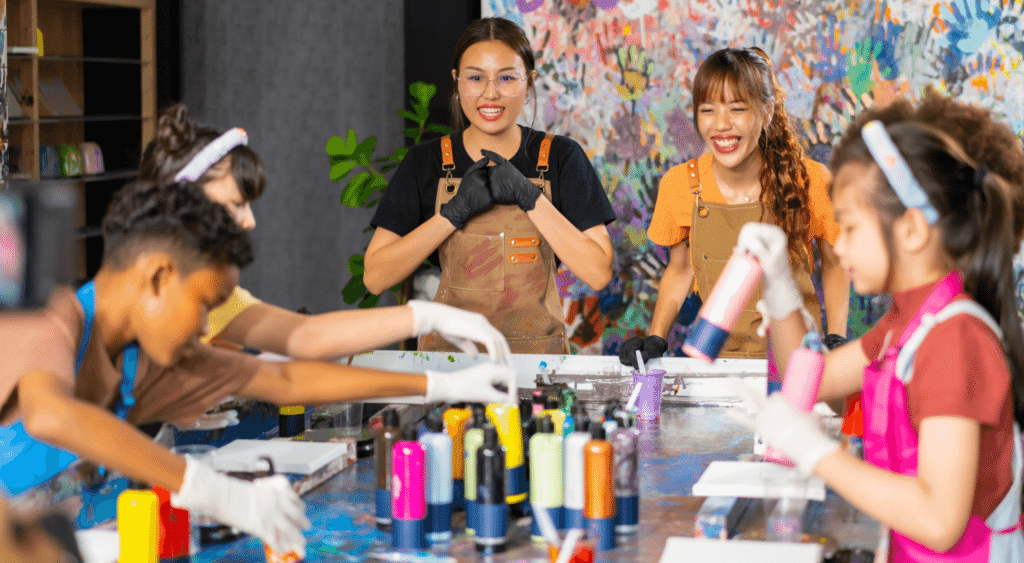Expert tips for substitute art teachers.

You didn’t earn a degree in art, and you haven’t painted since elementary school. However, an art teacher called in sick, and you accepted the assignment to be the substitute art teacher.
Whether it’s science, history, music, or art, you’ll be most successful when you lead the classroom with confidence. Don’t worry. You’re capable and qualified to substitute teach for an art class, even though you’re not a master artist.
Review the lesson plans.
If the art teacher left you with lesson plans, review them carefully. Note any needed supplies and locate them before class starts. Remember that elementary students are all at different skill levels. For middle or high school, art is an elective class. This may be the time of day when students explore their creative passion. Your enthusiasm and attitude will set the tone for the lesson.
Here are some other tips for teaching art lesson plans:
- Promote safety by reminding students to keep their area tidy and use the supplies correctly. Give them guidelines for safely handling any tools. As a substitute teacher, you should not be working with or supervising students using any sharp objects or flammable materials.
- Encourage creativity. There’s no “correct” way to create. Don’t stress if the class projects don’t turn out exactly like the sample. Focus on their efforts and don’t step in to “fix” a student project.
- Provide positive feedback throughout the class. Your encouragement can help students feel confident and motivate them to keep working.
- Once the students start working, walk around the room. Be prepared to step in to redirect or support, as needed.
- Keep an eye on the time. Art supplies can get messy quickly, especially for younger grades. You’ll need to leave a few minutes to clean up before the bell rings.
If the art teacher didn’t leave lesson plans, don’t worry. Ask a neighboring teacher or top student to tell you what the class was working on the previous day. Further down in the article, we’ll share some simple ideas you can use.
Don’t be afraid to ask for help.
As you read the lesson plans, you might find unfamiliar techniques or supplies. If there’s time, search online for the unknown terms before class starts.
But if there’s not time, it’s okay to ask for help. It’s much better to ask than struggle through a lesson.
Protect your clothes.
With most substitute teaching jobs, you want to look professional. But when it comes to substitute art teacher jobs, potential hazards to your wardrobe abound. Think paint, markers, and glitter.
Wear an apron or smock when teaching art lessons to protect your clothes from accidents. Consider bringing a change of clothes in the car, just in case.
Focus on monitoring the class, not participating.
Your job is to facilitate the lesson plan and manage the classroom. Though tempting, you’re not there to create a project of your own. You can’t supervise the class while you’re focused on something else.
Resist the temptation to join your students. Instead, move around the classroom, offer help, and be encouraging.
Have backup plans.
Teachers don’t always leave lesson plans. Sometimes, things come up unexpectedly, and they won’t have a chance to leave notes for you.
If that happens, having backup activities ready can be a lifesaver. Choose activities that are:
- Simple and easy to explain
- Age appropriate
- Require minimal supplies, nothing sharp
- Can be completed in a short amount of time (so you aren’t leaving unfinished projects for the classroom teacher)
4 Easy substitute art teacher creative ideas:
1. Book-inspired drawings.
This activity integrates language arts into art class. Read aloud a fun, age-appropriate picture book to the class. Then, pass out drawing paper and pencils (or crayons) and ask the students to:
- Draw a character from the story
- Create an alternate book cover
- Illustrate your favorite scene
- Think of a different setting for the book and draw what it might look like
- Draw an alternate ending
- Create a comic book panel of your favorite part
The exact assignment can vary depending on your student’s age and ability level, but the primary goal is for the book to inspire the student’s artwork.
2. Mysterious creatures.
What do you get when you cross a cow and a chicken? A Cowchen, of course! When your students combine two animals, they can create a unique creature.
For this project, encourage them to be creative and think outside the box. They can brainstorm for a few minutes, and then it‘s go time. Have them draw the picture and give their creature a name.
If there’s time at the end of class, have a quick show and tell so everyone can share their creatures.
Here are some sample combinations you can share to get their minds going:
- Unicorn + Pegasus = Unipeg
- Pig + Elephant = Pigephant
- Giraffe + Lion = Giralion
- Shark + Octopus = Sharktopus
Any combination works, and the more bizarre, the better! It’s a fun project that encourages imagination.
3. Wearable paper art.
What types of wearable art can your students create out of paper? Set out basic art supplies like paper, scissors, glue sticks, markers, and hole punchers, and let your students go to work.
They can try:
- Headbands
- Bracelets
- Hats
- Wings
- Necklaces
Encourage them to have fun and be creative. Once everyone is finished and the mess is cleaned up, have a mini fashion show where students showcase their wearable paper art creations.
4. Name art.
Pass out paper and pencils. Then ask your students to write their first name at least five times. But there’s a catch. They must use a new font each time.
They can experiment with different types of lettering, like bubble letters, block letters, or cursive. It’s okay for them to try to copy an established font or to create their own.
After they’ve written their name in five different fonts, have them show you their favorite. Hand them another piece of paper and ask them to write it that way again, in large letters in the center of the page. Then, ask them to decorate it however they want.
They can draw patterns, color each letter differently, or glue on shapes they cut out. The result will be a unique and personalized piece of name art they can proudly hang up in their room.
Grow as a substitute teacher with Kelly Education.
Even if you aren’t an artist, these tips can help you confidently accept substitute teaching jobs in the art room. You can inspire the next generation of creative thinkers!
Want to get more substitute teacher tips? Kelly Education shares everything you need to know about substitute teaching. Check out all our advice in our library! Here are a few topics to get you started:
- Substitute teacher dress codes – what to wear.
- What to bring in your sub bag
- How to introduce yourself to the class
Want to become a substitute teacher? Fill out our brief interest form and one of our recruiters will contact you to answer your questions and share more about opportunities to become a sub teacher with one of our school district partners.
View Related: Article Workplace culture
You might like
What to wear as a male substitute teacher.
3 minute read
What to wear as a male substitute teacher.
3 minute read
Find your next job
Discover thousands of temporary, full-time, and remote jobs for beginning and experienced job seekers.



